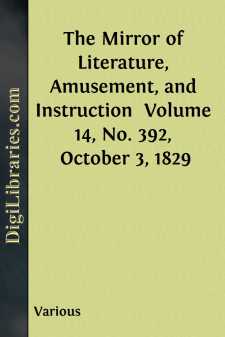Categories
- Antiques & Collectibles 13
- Architecture 36
- Art 48
- Bibles 22
- Biography & Autobiography 813
- Body, Mind & Spirit 142
- Business & Economics 28
- Children's Books 17
- Children's Fiction 14
- Computers 4
- Cooking 94
- Crafts & Hobbies 4
- Drama 346
- Education 46
- Family & Relationships 57
- Fiction 11829
- Games 19
- Gardening 17
- Health & Fitness 34
- History 1377
- House & Home 1
- Humor 147
- Juvenile Fiction 1873
- Juvenile Nonfiction 202
- Language Arts & Disciplines 88
- Law 16
- Literary Collections 686
- Literary Criticism 179
- Mathematics 13
- Medical 41
- Music 40
- Nature 179
- Non-Classifiable 1768
- Performing Arts 7
- Periodicals 1453
- Philosophy 64
- Photography 2
- Poetry 896
- Political Science 203
- Psychology 42
- Reference 154
- Religion 513
- Science 126
- Self-Help 84
- Social Science 81
- Sports & Recreation 34
- Study Aids 3
- Technology & Engineering 59
- Transportation 23
- Travel 463
- True Crime 29
The Mirror of Literature, Amusement, and Instruction Volume 14, No. 392, October 3, 1829
by: Various
Categories:
Description:
Excerpt
The Duke's Theatre, Dorset Gardens.
The above theatre was erected in the year 1671, about a century after the regular establishment of theatres in England. It rose in what may be called the brazen age of the Drama, when the prosecutions of the Puritans had just ceased, and legitimacy and licentiousness danced into the theatre hand in hand. At the Restoration, the few players who had not fallen in the wars or died of poverty, assembled under the banner of Sir William Davenant, at the Red Bull Theatre. Rhodes, a bookseller, at the same time, fitted up the Cockpit in Drury Lane, where he formed a company of entirely new performers. This was in 1659, when Rhodes's two apprentices, Betterton and Kynaston, were the stars. These companies afterwards united, and were called the Duke's Company. About the same time, Killigrew, that eternal caterer for good things, collected together a few of the old actors who were honoured with the title of the "King's Company," or "His Majesty's Servants," which distinction is preserved by the Drury Lane Company, to the present day, and is inherited from Killigrew, who built and opened the first theatre in Drury Lane, in 1663. In 1662, Sir William Davenant obtained a patent for building "the Duke's Theatre," in Little Lincoln's Inn Fields, which he opened with the play of "the Siege of Rhodes," written by himself. The above company performed here till 1671, when another "Duke's Theatre." was built in Dorset Gardens, by Sir Christopher Wren, in a similar style of architecture to that in Lincoln's Inn Fields. The company removed thither, November 9, in the same year, and continued performing till the union of the Duke and the King's Companies, in 1682; and performances were continued occasionally here until 1697. The building was demolished about April, 1709, and the site is now occupied by the works of a Gas Light Company.
The Duke's Theatre, as the engraving shows, had a handsome front towards the river, with a landing-place for visiters by water, a fashion which prevailed in the early age of the Drama, if we may credit the assertion of Taylor, the water poet, that about the year 1596, the number of watermen maintained by conveying persons to the theatres on the banks of the Thames, was not less than 40,000, showing a love of the drama at that early period which is very extraordinary. All we have left of this aquatic rage is a solitary boat now and then skimming and scraping to Vauxhall Gardens.
The upper part of the front will be admired for its characteristic taste; as the figures of Comedy and Tragedy surmounting the balustrade, the emblematic flame, and the wreathed arms of the founder.
Operas were first introduced on the English stage, at Dorset Gardens, in 1673, with "expensive scenery;" and in Lord Orrery's play of Henry V., performed here in the year previous, the actors, Harris, Betterton, and Smith, wore the coronation suits of the Duke of York, King Charles, and Lord Oxford.
The names of Betterton and Kynaston bespeak the importance of the Duke's Theatre....












